 Aaaah, Halloween is here again! Candy, costumes, trick-or-treaters, and for the third year in a row, another “Cameras of the Dead” post!
Aaaah, Halloween is here again! Candy, costumes, trick-or-treaters, and for the third year in a row, another “Cameras of the Dead” post!
This being my 5th Cameras of the Dead article, you probably already know what to expect. Three cameras from my “camera graveyard of death” (aka my basement) that for one reason or another won’t work. I know I say it every year, but despite my generally good luck shooting old cameras and Breathing New Life into Old Cameras, I am not always successful. Maybe the camera is physically damaged and beyond repair, maybe it kinda worked and I attempted to make it better, but ended up making it worse, or in some instances, maybe the camera actually does work, but there’s some other reason like lack of available film to shoot it with. Regardless of the reason, these articles are my way of sharing a little bit of info on cameras that can’t be shot, but are still interesting enough to share what I know.

This post pays homage to George Romero’s fourth film, “Land of the Dead”. First released in 2005, Land of the Dead was the first in Romero’s second trilogy of “…the Dead” movies and in my opinion, the only one that lives up to the quality of the original three. After taking a 20 year break from zombie movies, Romero returned with a larger budget and some A-list actors like Dennis Hopper and John Leguizamo. The movie explores the idea of zombie intelligence first seen in “Day of the Dead”, and is rife with Romero’s typical social commentary like the divide between rich and poor that permeates every Romero film.
Although Romero has since passed away, there is no shortage of “Walking Dead”, “Night of the Living Dead” or whatever other spin on the zombie concepts being created. And like the never ending onslaught of horror movies, there will always be more Cameras of the Dead!
Minolta 35 Model II (1953)
This is a Minolta 35 Model II rangefinder made by Chiyoda Kogaku starting in 1953. Despite the Roman numeral II in the name this was actually the 7th variation of the original Minolta 35, first released in 1947. The entire Minolta 35 series is loosely considered a copy of the Leitz Leica II, but had several significant differences, making it more of a Leica-inspiration, rather than a direct copy. The entire Minolta 35 series was very successful and stayed in production for 12 years before being discontinued in 1959.
Film Type: 135 (35mm)
Lens: 45mm f/2.8 Chiyoko Super Rokkor coated 5-elements
Lens Mount: M39 Screw
Focus: 3 feet to Infinity
Viewfinder: Coincident Image Coupled Rangefinder
Shutter: Cloth Focal Plane
Speeds: T, B, 1 – 1/500 seconds
Exposure Meter: None
Battery: None
Flash Mount: Coldshoe and FP and X Flash Sync
Weight: 587 grams (body) / 737 grams (w/ lens)
Manual: http://www.cameramanuals.org/minolta_pdf/minolta-35_color.pdf
History
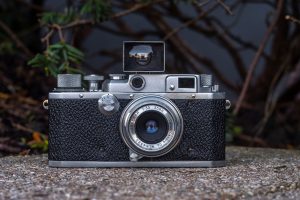
When you think of the most common “Leica Thread Mount” copies of the 20th century, most people probably first think of Canon, as they were one of the first to do it, and definitely the first to do it right. Canon’s earliest Leica copies were every bit as good as their German counterparts and also began to improve upon the German design almost from the start.
Besides Canon, you can’t ignore the massive number of Soviet copies, most made by FED and KMZ, who (mostly) successfully recreated the formular. Although the Soviets would eventually improve upon the Leica’s feature set with things like hinged rear doors, combined image coincident rangefinders, and rapid wind levers, the Soviets could never quite match Leitz in build quality like the Japanese did. Beyond that, there were also Leica clones by Nicca/Yashica, Leotax, Tanack, Kardon, and even the Chinese Shanghai copy.
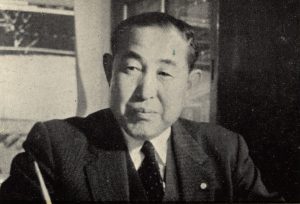
One company that few people would likely associate as making a Leica copy was Minolta, or as they were then called, Chiyoda Kogaku. This is interesting because the man who formed Chiyoda Kogaku, Kazuo Tashima, was infatuated with German camera design so much, that he hired two German technicians to help him build his earliest cameras. The first Minolta cameras were heavily influenced by German models like the Plaubel Makina and the Zeiss-Ikon Ikonta and Icarettes. In 1937, Minolta would launch the Minoltaflex, essentially a copy of Franke & Heidecke’s Rolleicord. The Minoltacord would evolve into the Minolta Autocord, which borrowed (and improved) heavily from the Rolleiflex.
So, with Minolta’s heavy influence of German camera companies, it should be no surprise to know that at one time they did have a Leica-inspired camera which was then called the Minolta 35.
Although Kazuo Tashima clearly had no problem releasing Minolta cameras that were heavily based off German design, he was consistent in that no Minolta camera would ever be an exact copy. Any new camera to bear the Minolta name should improve upon the original model and be unique in it’s own way. It is perhaps this reason that the Minolta 35 is often left off the list of Leica copy cameras as it was quite different from the very beginning.

In fact, the Minolta was more different than it was the same as the Leica, sharing only the same 35mm film format, cloth focal plane shutter (although it was of a different design), 28.8mm “flange to film” distance, and it shared the same 39x1mm screw lens mount.
First released in 1947, the Minolta 35 had a combined coincident image rangefinder, a self-timer, hinged rear film door, and most significantly, shot 24x32mm exposures, which at the time was a standard in Japan, and would yield four extra exposures on a single 36-exposure film cassette. It came standard with a very good Super Rokkor 45mm f/2.8 that was said to be superior to the Leitz Elmar found on many Leicas.
The Minolta 35 was one of the first Japanese made cameras to see success outside of Japan after the war. Although Nippon Kogaku would release their first Nikon rangefinder in 1948 and Canon had been producing their Leica copies since the mid 30s, it was Tashima’s knowledge of the German camera industry and the contacts he had developed which allowed his cameras to get a bit more exposure.

By the early to mid 1950s, the Japanese camera industry exploded, and like their competitors, Chiyoda Kogaku saw success with their interchangeable lens 35mm rangefinders. For reasons that are beyond the scope of this article, Chiyoda decided that continuing to pursue the professional 35mm camera market wasn’t in their interests, and in 1955 would release the Minolta A, a fixed lens, moderately priced rangefinder for the advanced amateur market.
Like Nippon Kogaku, by the end of the 1950s, Chiyoda saw the future of professional photography in the Single Lens Reflex and in 1958 would release the Minolta SR-2 SLR. Less than a year later, the last of the Minolta 35 series would end production.
Today, the Minolta 35 series are highly desirable by collectors as they are the rare example of a “Leica inspired” 35mm rangefinder that never pretended to be a Leica. Sure, later iterations of Canon and Soviet Leica copies evolved quite always from their Leica II roots, but the Minolta 35 was always different from the very beginning. Adding to the allure was Chiyoda Kogaku’s excellent reputation for optics. Like the Canon Serenar and Nippon Kogaku Nikkors, the Rokkor and Super Rokkor lenses are very sharp and can fetch huge dollars both for use on Minolta rangefinders and adapted digital cameras.
My Thoughts
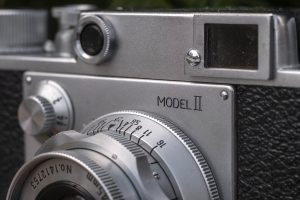
This Minolta 35 Model II was graciously loaned to me by fellow collector Jason Denlinger who had posted on the Facebook Vintage Camera Collectors group asking if anyone knew how to repair them. I am always one for a challenge and offered to take a look at his camera. When it arrived, I could clearly see the cloth shutter curtains had become detached from the spools they were supposed to be connected to. Sadly, this is a common problem with nearly any type of camera with a cloth shutter. Depending on age and how it was stored, the cloth ribbons that hold the curtains together can often become brittle and break, rendering the shutter inoperable. The only “fix” is to replace them.
I contacted Philippines based camera repairman, Jay Javier and asked for his thoughts on how to do this. Jay was gracious enough to send me several articles he had about removing the shutter from the Minolta 35 and replacing the curtains. I quickly realized after reading his notes that I was in over my head. To his credit, Jay tried to convince me that this wasn’t that difficult of a repair and that the Minolta 35 is one of the easier cameras to do this type of job on, but knowing it wasn’t even my camera to begin with, I decided to scrap any plan to repair it.
Without any hope of using this camera as I had hoped, I thought of a way that perhaps I could use the open shutter for some extremely long shutter exposures of the night sky. I found a lens cap that fit the Super Rokkor lens and used it as a way to open and close the shutter and I took it outside and shot some long exposure images of the sky around my house. I’ll just jump to the point where I tell you this didn’t work very well. Frankly, there’s no reason it couldn’t, I just didn’t devote the necessary time to do it right and I rushed the shots. Upon developing the film, I got mostly blank exposures with occasional streaks of light in them.
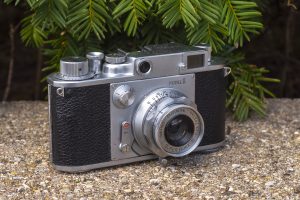
Had the camera worked however, I can say the Minolta 35 is a fantastic camera. The build quality is excellent, easily as good as anything coming out of Japan or Germany at the time. With a weight of 737 grams with the lens, the Minolta 35 is about as heavy as a compact SLR from the 1970s but it’s smaller size than an SLR gives an increased illusion of heft.
The viewfinder was of the coincident image variety that Canon and Nippon Kogaku were using at the same time. While not as small as pre-war rangefinders, the viewfinder was difficult to see through with prescription glasses. Thankfully, the rear eyepiece has a metal ring around it that when rotated functions as an adjustable diopter which helps matters a bit.
The rangefinder patch on this one was a bit cloudy and had this camera been in working order, I would have opened it up to clean it, but as it was I didn’t bother. Comparing the camera to that of the Nikon M and Canon IIB, I can say that it’s very comparable.
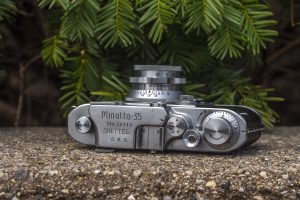
The top plate is where the Minolta resembles the Leica the most, but with a few minor changes around the shutter speed dial and the rewind mode selector. This particular camera was engraved “SHETTEL C.K.S.” The letters “C.K.S.” are original and stand for Chiyoda Kogaku Seiko where the camera was made, but I can only assume “SHETTEL” is the name of a person or company who originally owned this camera. If anyone reading this knows different, please let me know.
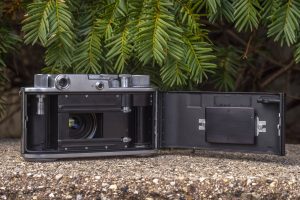
Perhaps the biggest improvement that Chiyoda, and nearly every other Japanese company, improved upon from the original Leica was a switch to a hinged rear door, instead of loading film through the bottom. It is said that Leitz’s insistence on bottom loading cameras was to protect the film from light leaks, but its just so darn inconvenient!
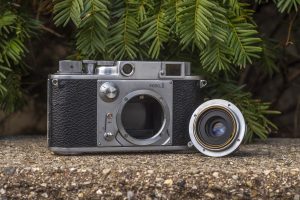
Being a Leica Thread Mount 35mm camera, means the lens screws off like any other camera with the same mount. There is a coupling arm at the 12 o’clock position of the lens mount that allows the rangefinder to detect the focus distance set on the lens, but otherwise the lens screws in as you would expect. The diameter and pitch of the threads are 39x1mm which means that any German or Japanese LTM lens will work on the Minolta.
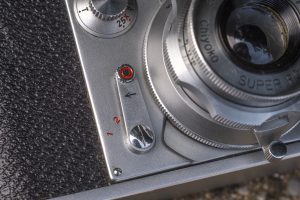
The Minolta 35 Model II has a self timer on the front plate with the numbers 1-3 printed in red. The manual strangely doesn’t explain what these numbers mean, but says that a full press of the lever is good for an 8-9 second delay, and “a degree of 1-3 the corresponding time will be about 4 seconds”. I guess what the’re trying to say is that the self timer will work in partial movements of less than 8-9 seconds if you only push it part way.
I really enjoyed this little camera, and am disappointed I couldn’t get it working. After coming back to the original owner and telling him I didn’t want to risk tearing down his camera to repair the shutter curtains, he told me that he really only cared about the lens. He felt he could get far more money for the lens than the camera body itself, so he told me that I could keep the body and I’d only have to send him back the lens, to which I agreed. So as I write this, I still have this camera in my collection, sans lens. Perhaps one day I’ll get enough courage to take Jay Javier’s advice and attempt to repair it. Of course, then I’ll have to call up Jason Denlinger and hope I can buy his lens back!
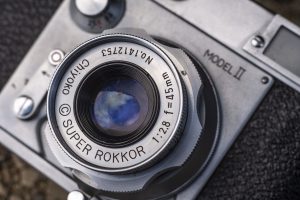
Although I couldn’t shoot the camera, I was able to handle it and experience what it might have been like. Minolta’s reputation for excellent optics makes me feel confident that had I shot some images, they would have looked marvelous. These Minolta 35s aren’t the cheapest cameras out there, but they’re still a value compared to most Leicas, and with the extra conveniences like the hinged rear door and coincident image rangefinder, I would recommend this all day over an original Leica from the same period.
Fun Trivia: The circle with the C symbol on the face of the lens is not a copyright symbol, it is what Chiyoda used to indicate that the lens was color coated.
Miranda dx-3 (1975)
This is a a Miranda dx-3 Single Lens Reflex camera made by the Miranda Camera Company and was in production from April 1975 through December 1976. It was Miranda’s first compact SLR and their first electronic SLR. Sadly, it was also the last camera designed by the company before they went bankrupt in late 1976. Although Miranda was already struggling when the camera went into production and the company had no experience building an electronic camera, the dx-3 was a surprisingly nice model with good ergonomics and a competitive feature set. Despite this, it was plagued with reliability problems, and Miranda’s poor reputation for quality doomed the camera before it ever hit store shelves.
Film Type: 135 (35mm)
Lens: 50mm f/1.8 Auto Miranda EC Coated 6-elements
Lens Mount: Miranda Bayonet and 44mm Screw Mount
Focus: 17 Inches to Infinity
Viewfinder: Fixed SLR Pentaprism
Shutter: Cloth Focal Plane
Speeds: B, 4 – 1/1000 seconds
Exposure Meter: TTL CdS cell w/ Viewfinder LED Readout
Battery: 4 x LR44/357 1.5v Batteries
Flash Mount: Hotshoe and PC X and FP sync port
Weight: 567 grams (body) / 790 grams (w/ lens)
Manual: http://www.cameramanuals.org/miranda_pdf/miranda_dx-3.pdf
My Thoughts
A Miranda in a “Cameras of the Dead” article? Of course there is!
Have you ever had that experience, perhaps when you were younger, of a special girl or boy that you liked, but he or she didn’t feel the same way about you? Well that about sums up my relationship with this brand of cameras. I have or have owned at least 10 Mirandas, and with the exception of one, they all don’t work, or in some way break WHILE I’m using them.
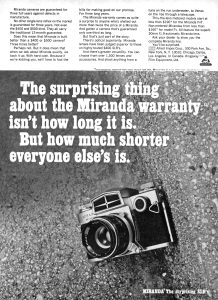
If you ask anyone who was active in photography in the 60s or 70s, they’ll likely tell you stories of how Mirandas had a poor reputation for quality, and if that was true when these things were new, imagine what half a century of age does to them. Making matters worse, Miranda’s already questionable quality control got worse near the end of the company’s existence, so if things were bad during their “glory days” imagine what it might be like to try and use their very last model.
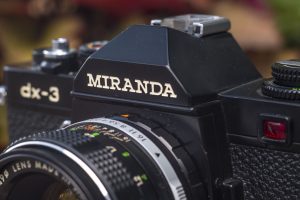
I present to you Miranda’s very last model, the dx-3. Miranda really wanted to compete with professional cameras like the Nikon F and release a model with similar features, but for a lesser cost. Every Miranda prior to the dx-3 had interchangeable viewfinders, dual bayonet/screw lens mounts, in body TTL metering, and came in a large and heavy all metal body.
By 1973, Miranda realized the writing was on the wall, and their previous models were big, heavy, and expensive to build. As a last ditch effort to modernize their cameras and use cost effective electronics, they started working on an all new, compact SLR with an electronic shutter, and a fixed pentaprism viewfinder.
Released in 1975, the all new dx-3 was available in black or chrome, and amazingly, was a nice looking camera with a competitive feature set, at least on paper. Perhaps it was Miranda’s already poor reputation, or the massive success of similar models by Olympus, Minolta, Pentax, and pretty much every other Japanese camera maker, but the dx-3 didn’t sell well. It was the final nail in the coffin for the company as they would go out of business less than 2 years after the model’s release.
Handling the Miranda dx-3 is surprisingly “not-Miranda-like”. The camera is nearly the same size as a Nikon FE and weighs only 30 grams less (567g vs 597g). The controls are all comfortably located, and even the shutter release is on the top plate where it appeared on nearly every other 1970s SLR.
The viewfinder is large and bright and features a really neat microprism focusing aide that they call the “Quadrascopic Image System” or QIS for short. According to the dx-3’s user manual, this system splits up any horizontal or vertical line in four (up/down and left/right) directions, hence the word “Quadrascopic” name. Now, many other SLRs have had microprism focus aides without such a goofy sounding name, so this was something I was looking forward to testing out myself.
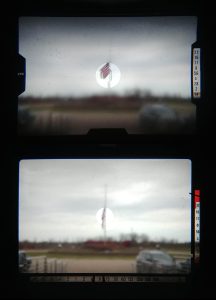
I am not going to pretend I fully understand how microprisms work, but the one in the dx-3 is different from any other I’ve seen. Click on the image to the right to get a full screen view of how it compares to a Canon EF. I show the same scene out of focus on both cameras. I used the Canon EF because it has what I consider to be a “normal” microprism. Look at the center of the flag pole on the Canon EF (bottom), the microprism “breaks apart” the pole to indicate that it is out of focus, but the pole itself is still lined up with the rest of the image outside of the microprism. Now look at the Miranda dx-3 (top) and you’ll see the microprism still breaks apart the pole, but the center of the pole is shifted to the side. Its almost like there is both split image and microprism focus aides at the same time! Although I don’t show it, when rotating the camera 90 degrees to shoot in portrait orientation, the effect works on horizontal lines as well. I found this QIS system quite unique and don’t recall ever seeing it in any other SLR made by any other company.
The rest of the camera was surprisingly well designed. The ergonomics were excellent, it wasn’t heavy, it had nearly every modern convenience available to a mid-range SLR in the mid 1970s including a full information viewfinder, flash hot shoe, electronic shutter, quality lenses, and even a provision for a motor drive. For all the reasons this camera failed, you can at least say the designers did their job.
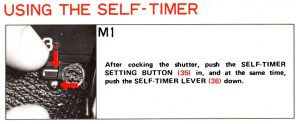
Reliability on these things is rather poor today as very few are found working. For all of the good things I can say about it’s looks and design, there still are some cost cutting measures such as the incredibly poorly designed self timer lever which is almost always found broken off. In fact, it’s so hard to find a picture of a dx-3 where the self timer level isn’t broken off, that I had to consult the dx-3 owners manual to find a picture of it.
The electronics of the dx-3 are also prone to failure. Whether this is a result of Miranda’s lack of experience in electronic cameras, or the materials used to make them, the rate of failure on the dx-3 is much higher than that of other 70s electronic SLRs. The electronics on the camera reviewed here were it’s main issue, despite the camera being in very nice physical condition.
I really wanted this camera to work. Maybe even more so than other Mirandas in my collection. It’s pretty, the viewfinder is super cool, and I just have this completely illogical fondness for the brand. I guess I’m a sucker for an underdog story, but alas, it was not meant to be. This Miranda dx-3, like the company who made it, is dead. Based on it’s nice physical condition, it likely wasn’t used much throughout it’s life, which is a shame, but you never know. I have a tendency to acquire working examples of dead cameras after posting one of these articles, so maybe one will come my way someday soon!
Ricoh R1 (1994)
This is a Ricoh R1 compact 35mm camera made by the Ricoh Camera Company starting in 1994. It was a ‘premium’ compact 35mm camera with an innovative panoramic feature that changed the focal length of the fixed 4-element 30mm lens to 24mm when in that mode. There were two variants called the R1s and R1e, the first of which had different cosmetics and an improved lens, and the second which removed the panoramic feature. Although an unrelated camera, it is often seen as the little brother to the top of the line Ricoh GR1.
Film Type: 135 (35mm)
Lens: 30mm / 24mm f/3.5 Ricoh Lens Coated 4-elements
Focus: 14 Inches to Infinity
Viewfinder: Reverse Galilean w/ Focus Confirmation Readout
Shutter: Programmed Electronic Shutter
Speeds: 2 – 1/400 seconds, Stepless
Exposure Meter: Dual Silicon Photo Diode with Programmed Auto Exposure
Battery: CR2 3v Lithium Battery
Flash: In-Body Electronic Flash w/ Red Eye Reduction and other modes
Weight: 140 grams (no battery)
Manual: http://www.butkus.org/chinon/ricoh/ricoh_r1/ricoh_r1_scan.pdf
My Thoughts
 Throughout the camera world, there are a number of oxymorons that often get used to describe certain models. “Poor Man’s Leica” is one of my favorites. Such a camera doesn’t exist, because Leica never made cameras for “poor people” and if there was a camera that someone who was poor could afford, it wouldn’t be a Leica.
Throughout the camera world, there are a number of oxymorons that often get used to describe certain models. “Poor Man’s Leica” is one of my favorites. Such a camera doesn’t exist, because Leica never made cameras for “poor people” and if there was a camera that someone who was poor could afford, it wouldn’t be a Leica.
Another favorite of mine is the term “fast zoom lens”. Due to the complexity of their design, zooms are never fast. Yes, there are some like the Sigma 50-100 f/1.8 DC HSM Art lens, but it cheats somewhat by being an APS-C lens, and can’t cover a full 35mm frame. Plus, the lens costs over $1100 and its 2x range is rather limited at best. The fastest you’ll typically see for practical zooms is in the f/2.8 range which is “fast for a zoom” but still not “fast”.
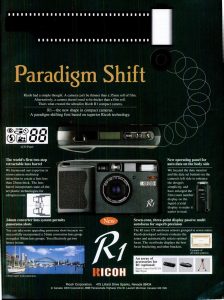
But this article isn’t about a Poor Man’s Leica or a Fast Zoom its about a camera that is often labeled with another oxymoron, the “premium compact”. Originally selling for $299 in 1995 when it was first introduced, that price compares to about $500 today making it quite an investment for the typical point and shoot customer.
With the R1, Ricoh entered into the low end of the premium compact segment (should I call it a ‘poor man’s premium compact’?) with a sleek and compact body, a 4-element 30mm lens, full programmed auto exposure, seven zone auto focus system, flexible 2 to 1/500 second shutter, and a sleek 24mm wide angle panoramic mode using what Ricoh called a ‘conversion lens group’.
Panoramic photos were a bit of a fad in the mid to late 90s with nearly every manufacturer incorporating some form of panoramic modes in their models. Most cameras, like the Nikon AF600 used nothing more than a mask that would swing into position masking off the top and bottom of the 24x36mm frame creating a ‘cropped’ 18x36mm image. Minolta created a camera called the Riva Panorama that had a permanent panoramic mask but included a fixed wide angle 24mm lens to improve the panoramic effect. Ricoh simply combined the two methods, with a movable panoramic mask and a lens that could “widen” to 24mm when needed.

The Ricoh R1 was certainly a good looking camera with a neat feature set that was well worth the asking price to buy one, and of course, there are certainly examples of much more expensive premium compacts out there, such as Ricoh’s own GR1, the Contax T-series, and the Nikon 28Ti.
As impressive as many of these models are, they all have the same weakness…electronics. Each of these cameras were produced in an era with increasing amounts of technology in them. Circuit boards with electronic sensors and CPUs were replacing mechanical gears and levers. Lightweight materials such as plastic and rubber replaced metals like brass and chrome. Cameras got smaller and lighter, but they also became less tolerant of variances in temperature or physical bumps and small drops. There’s an old joke about someone who accidentally dropped an Argus C3 on the floor and another person asks, “is the floor ok?” Drop a plastic camera like the Ricoh R1 on the floor and it likely won’t ever work again.

When it comes to the “premium” label given to cameras like the Ricoh R1 and when celebrities like Kendall Jenner or Chris Hemsworth promote a camera like the Contax T2 and prices go through the roof, its really important to remember that no matter how much money you spend on a camera like this, the chances for it to not work, or have problems is extremely high.
Which brings me to this Ricoh R1. This is a very neat camera. I loved it’s looks and it’s compact size. At 140 grams, it is very lightweight, but the body is sturdy and doesn’t creak in your hands. It fits easily into a shirt pocket and with it’s reputation of having a great semi-wide angle lens, I could see this being a go-to “zoo” camera that I used for spontaneous family photos.
This camera came to me in excellent condition and in it’s original packaging with the manual, some stickers that you’re supposed to include with film when having it processed, and even a warranty card. I had really high hopes for it, but upon inserting some batteries into the camera, other than a constant winding of the film advance, nothing happened. The LCD wouldn’t light up. The front lens never extended out of the camera. Nothing showed up in the viewfinder. It was dead.
The worst part about a dead electronic camera is that there’s almost nothing you can do about it. Maybe cleaning the battery contacts might help if there is corrosion or some other debris in the battery chamber, but that’s about it. There’s no amount of naphtha oil that will help and the best precision screwdrivers and lens spanners are useless. If the electronics are dead, the camera is simply never going to work again. Even if there was some electronic circuit that could be replaced, the parts would usually need to come from another working camera, and if you had a working camera, why not just use that?
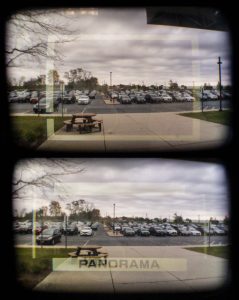
After fiddling with the camera for a brief while, I actually got the viewfinder to sort of work and I was able to get a glimpse into what shooting the R1 might have been like. The viewfinder uses some type of projected bright lines using LCD technology that can change the framing of the image depending on whether you are in Panoramic mode or not.

Like many other 1990s point and shoot cameras with a Panoramic mode, the camera uses a mask in the film compartment that covers up part of the 24x36mm frame, but unlike those cameras, the R1 also widens the focal length of the lens from 30mm to 24mm, increasing the amount of image that fits into the smaller 18x36mm frame. I believe this is accomplished via an extra lens element that swings into position within the camera body, acting like a correction filter, but since I couldn’t actually use the camera, I can’t be sure.
There is an awful lot to like about the Ricoh R1. I don’t know if the pictures adequately portray how compact and nice this camera is to hold. The form factor of this camera is excellent. The feature set is quite competitive with other mid priced point and shoot cameras of the 1990s, and although I never got to shoot any film through it, Ricoh lenses generally receive positive praise, so I’m sure I would have gotten great photographs from it.
But that’s not what happened. I am sure there are many other R1s out there just like this one. Dead.
My Conclusions
In all of these “Cameras of the Dead” posts, I say the same thing over and over about how it is important to know that not every camera I come across works. Sometimes the reviews I write are on cameras that work perfectly, and others that barely work but I can at least get some pictures out of. In the case of the Minolta 35, Miranda dx-3, and Ricoh R1 being reviewed here, they made their last ever photographs at some point prior to them coming my way.
 It is important to know that as the years go by, more cameras will die. The metal springs that tension shutters, the cloth curtains, the glue holding lens elements together, and the various electronic circuits that make up cameras from the 20th century will continue to fail.
It is important to know that as the years go by, more cameras will die. The metal springs that tension shutters, the cloth curtains, the glue holding lens elements together, and the various electronic circuits that make up cameras from the 20th century will continue to fail.
Sadly, the failure rate of the “electronic age” is even higher. The three cameras in this article represent three different eras, a fully mechanical camera, a somewhat mechanical camera with a lot of electronics, and an all electronic camera. I believe there will be a time in another couple of decades where very few electronic cameras still work. Models from the 80s, 90s, and early 2000s will all be display pieces only with the occasional 1950s rangefinder still chugging along. Planned obsolescence is a bitch!

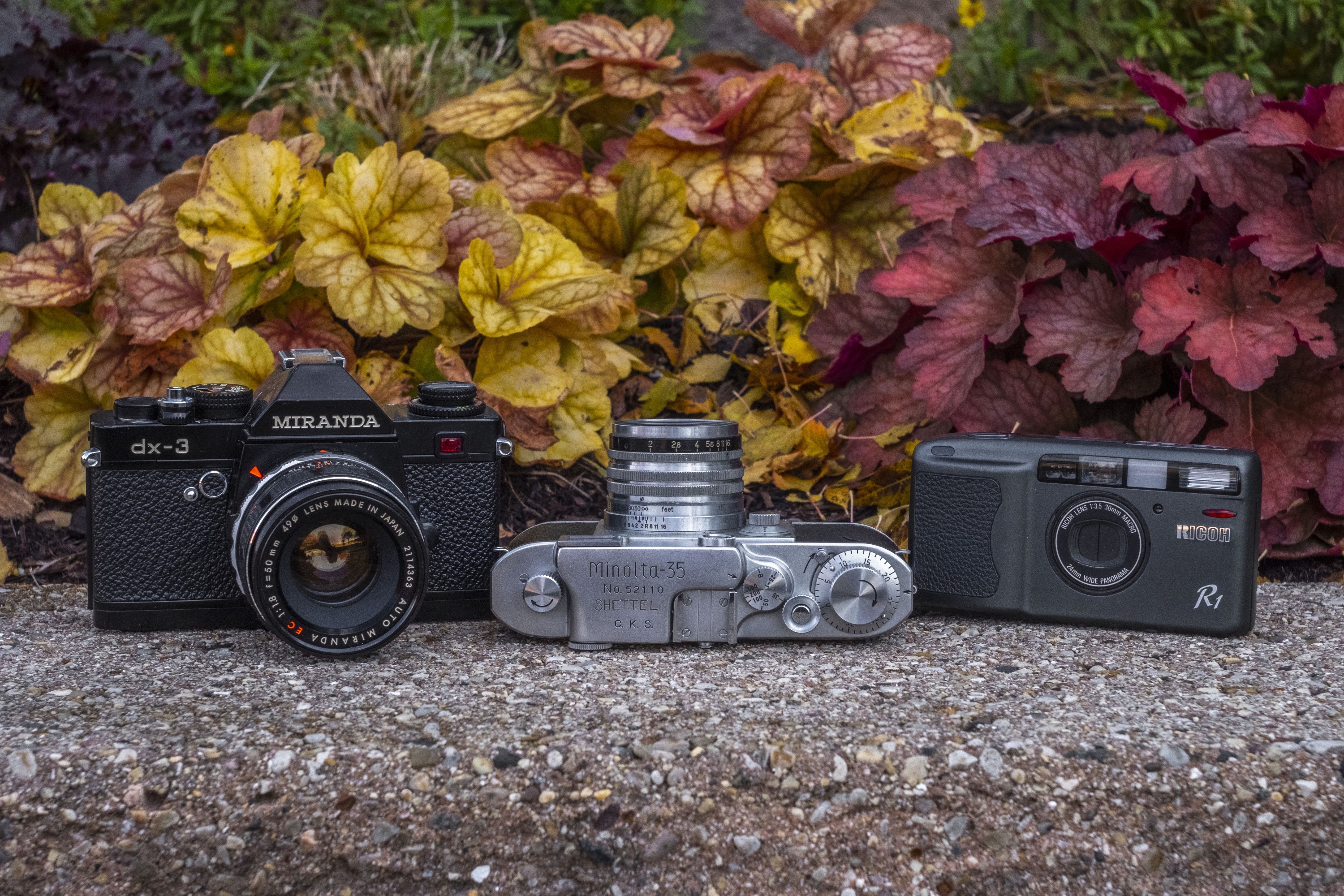
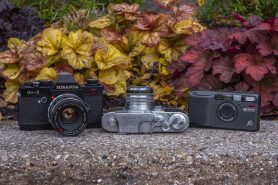








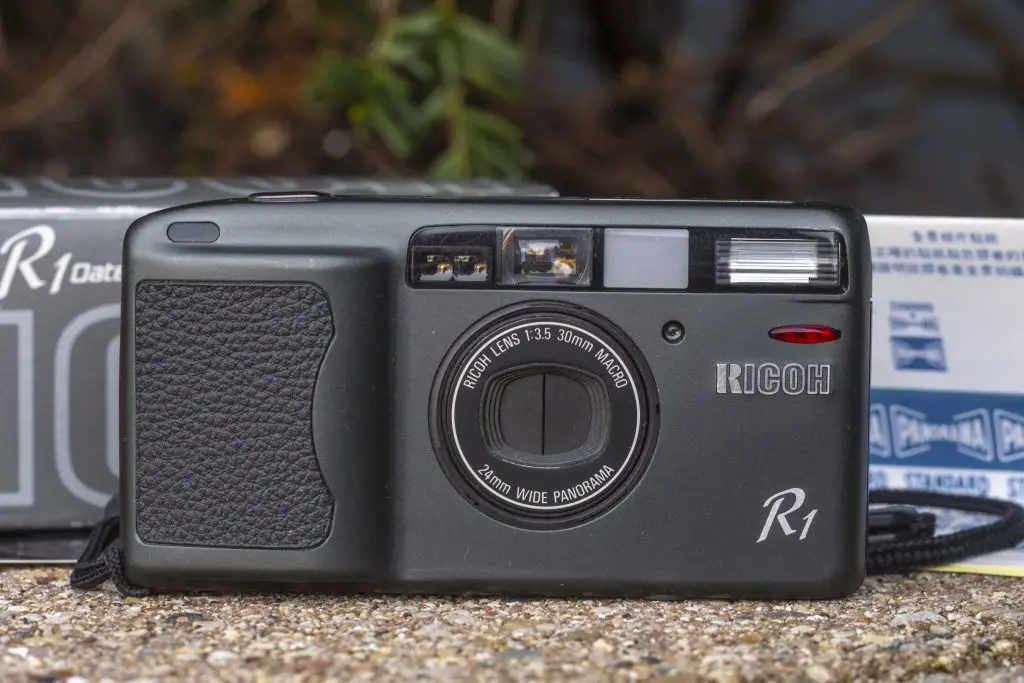






Kind of like my love of old cars. Each were distinctive and even if not working well their technology and looks were enjoyable to look at.
Yes I have a Ricoh r1 and it’s a wonderful camera with many great features. Everything works on mine except for one minor flaw. The lcd screen is dead so everything works but you have no idea what your settings are. I took a fairly good roll of pictures not knowing what setting it was on at any time. Too bad because it fits in your pocket so well. I guess it’s back to my 1950’s Contessa. It weighs as much as 4 Ricohs and it really is a stretch to fit in my pocket but 60+ years later (boom) you know what you have.
I’m embarrassed to say, I’ve acquired two(!) Miranda dx-3’s. for mine, the shutter speed ASA dial is jammed. Won’t turn past 1/8th sec on one, 1/30th on the other, with or without batteries. One worked when I got it, but I rotated the dial too much, lifted up on the ASA ring while turning the film speed, and that was it. Kaput. Any thoughts?
Yeah, burn it! I don’t think any of them work! 🙂
Lol. I followed your link, to Facebook’s Vintage Camera Collector’s group, and signed up. I posted my question there — they might have the same answer! The maddening thing, on top of the first camera breaking, is how it broke. When the dial still rotated, the camera would only fire at one shutter speed (1/60th?), even with fresh batteries. Fair enough, I thought — dead electronics. After the MECHANICAL failure of the dial, the slow shutter speeds work! I literally timed the 2- and 4-second speeds, and they were spot-on! So, if I want to become a Camera Repairman of the Dead, I could try untangling this whole mess! Or, I could take your advice, and burn them! First, I remove the f/1.4 50mm lenses that came with each — those are nice pieces of glass!
Hallo! I like this post because it gives a lot of useful information.
By the way, do you need a selftimer leverfor your Miranda DX-3? I made two because I also have a DX-3 originally with a broken one. I made them out of aluminum exactly to the original one. It works perfect an it looks like the original. So, if you need one, give me information